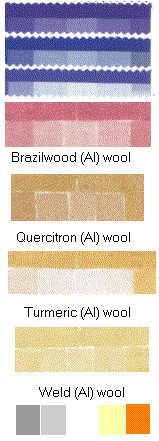
 |
The effect of light on museum objects |
 Light damages museum objects rather quickly, compared to other factors which conservators become distraught over, such as RH.
Light damages museum objects rather quickly, compared to other factors which conservators become distraught over, such as RH.
The palest square in the centre of each of the seven cloth samples on the left has been exposed to thirty million lux hours of fluorescent light (there is much more about lighting units later). That is about 200 years in a permanent textile exhibition at 50lx, the museum standard for easily faded things. Above each faded patch is a strip of the same cloth which has been screened from light.
To the left of the central bleached patch is a slightly darker patch which has had about half the exposure. To the far left is a patch exposed for only 5 million lux hours.
Many dyes, both old and new, are faded perceptibly by 50 years of exposure to 50 lux for eight hours a day. 50 lux is not safe illumination. It is a compromise between deterioration and visibility.
To the right of the central, pale patch, the cloth has been exposed to 30 million lux hours behind a filter which absorbs all ultraviolet radiation from the lamp. The far right patch has been protected by an orange filter, which absorbs the high energy half of the light spectrum .
The samples at the top are the blue wool standards 3, 2 and 1. These are the standards used for assessing the resistance to fading of dyes.
Notice that the uv filter gives considerable protection: roughly equivalent to halving the light exposure. The orange filter gives better protection, roughly equivalent to reducing the exposure to one sixth, depending very much on the dye.
This picture is part of the data published by Padfield and Landi in: "The light fastness of the natural dyes", Studies in Conservation 1966 vol 11, 181-196.
The picture illustrates several aspects of light damage:
1. Even a dim light destroys objects at a rate that is unacceptable in a museum, where five hundred year durability should be a reasonable aim.
2. Ultraviolet absorbers confer a useful degree of protection but do not, as surprisingly many people believe, give total protection against fading.
3. An orange filter that removes the blue part of the spectrum is more protective, especially to curry powder (turmeric), but hopelessly distorts the colour rendering. This suggests that a pale orange filter that the eye does not notice will be beneficial. An incandescent lamp provides exactly this illumination, being very weak in blue radiation.
One other point that the picture on your screen does not necessarily illustrate is that an exhibition at 50 lux is rather depressing.
There is nothing that does more to give conservators the reputation of kill-joys than the sight of one, with frown and luxmeter, patrolling a new exhibition the day before the opening, telling the technician that he must turn down the lights.
Conservators need to understand light, because no one else is interested in the physics and psychology of exhibiting in a dim light. Architects are always trying to increase the brightness of indoor places, making vast atria with enough light to ensure exuberant growth of a miserably limited selection of exotic plants. It was not always so, as many dimly magnificent churches confirm.
Light is a difficult subject. The elegant abstractions of physics are complicated by the brain's insistence on interpreting the signal that reaches it from the eye. One cannot get far without understanding the basic units. I begin with the fundamental unit for light: the candela.

This work is licensed under a Creative Commons Attribution-Noncommercial-No Derivative Works 3.0 License.